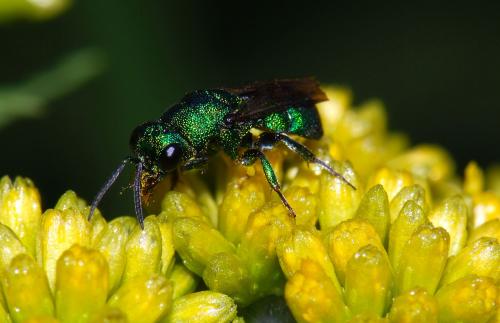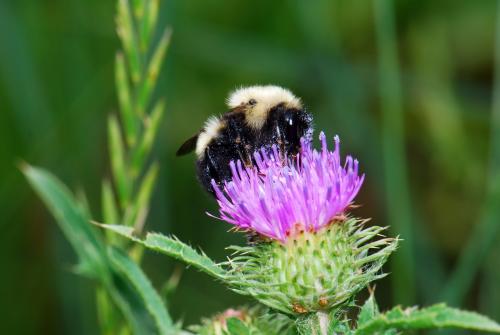eOrganic author:
Mary E. Barbercheck, Penn State University
Pollination, the transfer of pollen from male to female reproductive parts of the flower, can be carried out by wind or by animals such as insects, birds, and bats. Pollination by insects is essential for the production of fruit by many common crop plants. Some crops that require insect pollination include those in the rose family (for example, apples, pears, stone fruits, almonds), cucurbits (melons, cucumbers, pumpkins, squash), onions, and carrots. The most common insect pollinators in agricultural systems are bees. Flies, wasps, beetles, moths, and butterflies can also serve as pollinators. Commercially, honeybees are by far the most common managed pollinator. Other kinds of pollinators, for example, bumblebees, orchard mason bees, and leaf cutter bees are cultured and sold for managed pollination. The farm landscape can be managed to conserve native pollinators, which may compensate for a lack of pollination by honeybees (Black et al., 2007).

Figure 1. Cuckoo wasp (Family: Chrysididae) on goldenrod (Solidago sp.). Photo credit: Rajwinder Singh, Dept. of Entomology, Penn State University.

Figure 2. A bumblebee, Bombus vagans, on a thistle flower. Photo credit: Rajwinder Singh, Dept. of Entomology, Penn State University.
This article is part of a series discussing the ecology of insects in organic farming systems. For more information, see the following articles:
- Ecological Understanding of Insects in Organic Farming Systems
- Decomposers in Organic Farming Systems
- Pollinators in Organic Farming Systems
- Natural Enemies in Organic Farming Systems
- How Insects Damage Plants
- Plant Defenses Against Insects
- Insect Life Cycles
- Insect Populations
- Factors that Influence the Size of Insect Populations
- Diversity, Stability, and Productivity of Insect Populations
- Ecological Succession
- Insects in Ecological Communities
- Additional Resources for an Ecological Understanding of Insects in Organic Farming Systems
References and Citations
- Black, S. H., N. Hodges, M. Vaughn, and M. Shepherd. 2007. Pollinators in natural areas: A primer on habitat management [Online]. Invertebrate Fact Sheet. The Xerces Society. Available at: http://www.xerces.org/pollinators-in-natural-areas-a-primer-on-habitat-management/ (verified 16 March 2009).
Additional Resources
- Altieri, M., C. I. Nichols, and M. A. Fritz. 2005. Manage insects on your farm: A guide to ecological strategies. Sustainable agriculture network handbook series book 7. (Available online at: http://www.sare.org/Learning-Center/Books/Manage-Insects-on-Your-Farm) (verified 25 April 2011).



